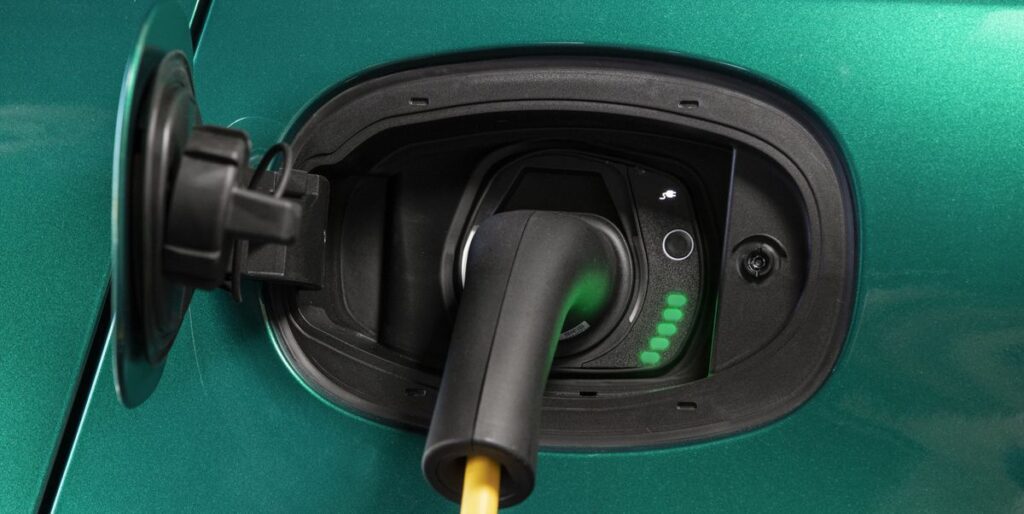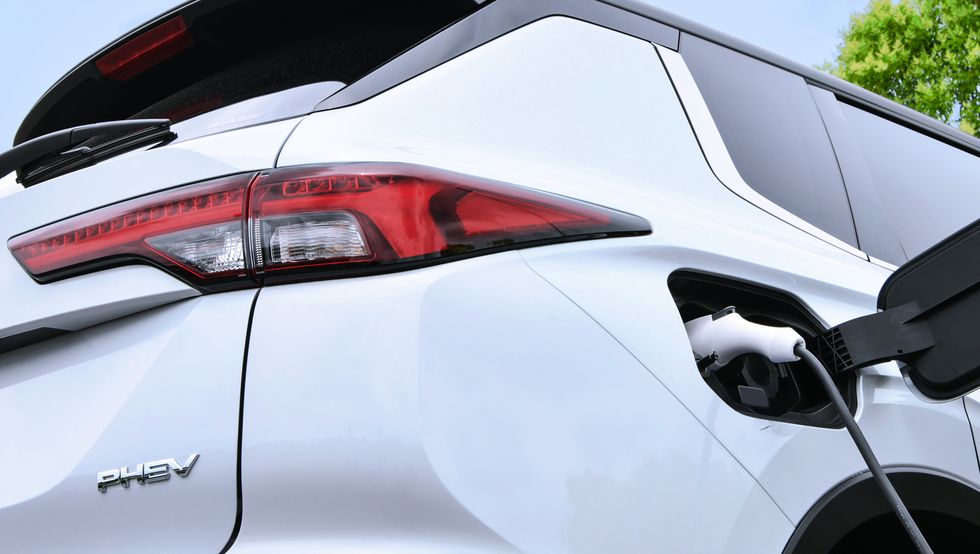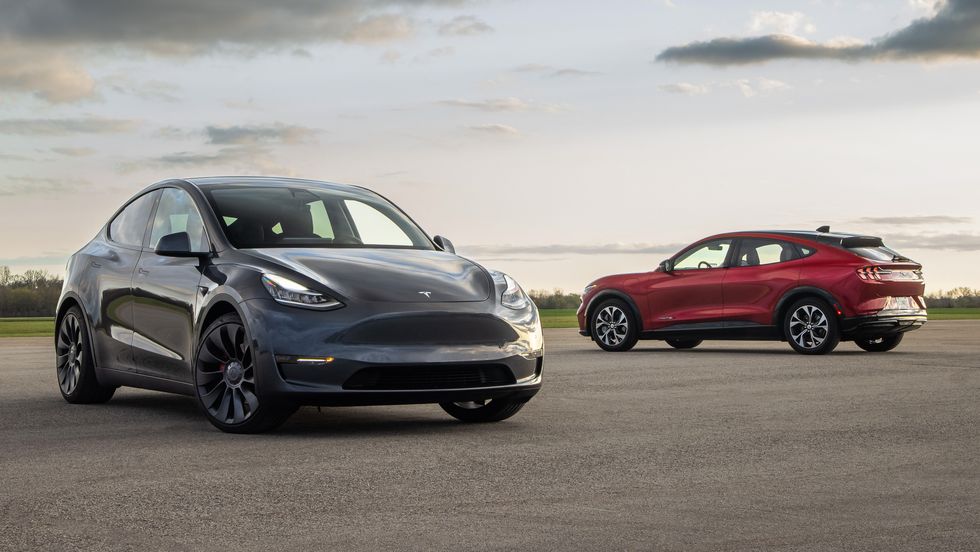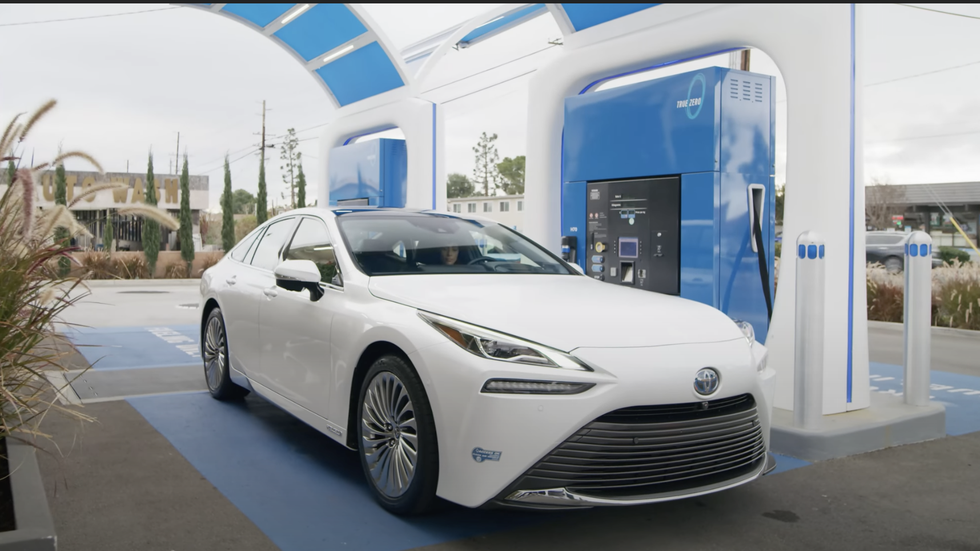The Difference Between Electric and Electrified Vehicles

You may have heard the term electrified to describe a vehicle. Despite what it sounds like, an electrified vehicle is not always synonymous with an electric vehicle. Every electric vehicle is electrified, but not every electrified vehicle is fully electric, and some still have internal combustion engines.
Electrified cars and trucks can be broken down into four main categories: hybrid electric vehicles, such as the Toyota Prius; plug-in hybrid electric vehicles (PHEVs), such as the Mitsubishi Outlander PHEV; battery electric vehicles (BEVs), including the Tesla Model 3; and hydrogen fuel cell electric vehicles, such as the Toyota Mirai. When automakers promise to “fully electrify” their lineup of vehicles, they’re typically talking about offering a combination of vehicles that fall under one of the four aforementioned categories.
You might have heard the term “mild-hybrid,” too. An example is the Ram 1500 full-size pickup, which comes standard with the brand’s eTorque hybrid-assist system fitted to its 3.6-liter V-6. While this technology helps save fuel or add extra power as needed, this type of hybrid-assist system cannot power a vehicle without the use of the gasoline-fed engine. That’s why it doesn’t make the cut in this list of four electric car categories.
Let’s look at their similarities and differences, along with the pros and cons of each type.
Toyota
Hybrid Electric Vehicles
Hybrids are the most common electrified cars. The most popular example of the breed, the fuel-sipping Toyota Prius, has been on sale for more than two decades. A hybrid’s powertrain consists of an internal-combustion engine paired with at least one electric motor and a battery pack. Keep in mind, this is the same basic engineering blueprint used in a plug-in hybrid vehicle, though we’ll touch more on PHEVs in a moment.
For example, the 2023 Prius’s 150-hp 2.0-liter four-cylinder is paired with two electric motors, and these three power sources are combined in a way that creates a continuously variable automatic transmission (CVT), which metes out power to the front wheels. The Prius can drive purely on electric power for short periods of time, though only at low speeds. Energy is fed back to the battery by the car’s regenerative braking system. Unlike plug-in hybrids and battery electrics, a hybrid never needs to be recharged using a plug and outlet.
Because the gas engine and electric motors work together to power the vehicle, the Prius is what’s known as a parallel hybrid. By contrast, a series hybrid employs a similar layout, though only the electric motor powers the car. The gas engine is there only to serve as an onboard generator to recharge the battery and add range. The recently discontinued BMW i3 city car was available with a series hybrid powertrain.

Mitsubishi
Plug-in Hybrid Electric Vehicles
Even the most techno-phobic car shopper will quickly grasp the difference between a hybrid and a plug-in hybrid. The differentiator here is the size of the battery pack. A plug-in hybrid employs a larger battery, one that’s capable of powering the vehicle on electric power for a significant distance, typically in the range of 20 to 50 miles before the gas engine needs to kick in to help.
Drivers of a fully charged 2o23 Mitsubishi Outlander PHEV, for example, can drive an estimated 38 miles on battery power alone before the gas-fed engine fires into action. Oftentimes, the benefits of a plug-in hybrid go beyond the fuel savings realized by cruising on battery power. Many plug-in hybrids also deliver performance and fuel-economy benefits when working in cooperation with the gas engine.
As the name implies, a plug-in hybrid can be plugged in to recharge its battery pack. That said, these types of vehicles never have to be plugged in for a recharge, as they can always run in their hybrid mode.

Michael Simari|Car and Driver
Battery Electric Vehicles
We’re officially done with fossil fuels and gas tanks when talk turns to battery electric vehicles (BEVs). These employ a minimum of one electric motor and a battery pack. Popular examples of BEVs include all Teslas, the Ford Mustang Mach-E, and the Chevrolet Bolt, to name a few.
Many BEVs—often referred to simply as EVs—offer at least two sizes of battery pack and two powertrain configurations.
This flexibility allows a car shopper the choice to prioritize things like a lower base price, added performance, or more driving range. For example, the Tesla Model Y offers base, Long Range, and Performance trims. The Long Range provides an EPA-estimated 330 miles of range, versus 303 miles in the Performance and 279 miles for the base model. As you guessed, the Model Y Performance counters this with faster acceleration and a higher top speed. During our testing, the Model Y Performance needed only 3.6 seconds to zoom to 60 mph.
Despite all the excitement around electric vehicles, there are still some drawbacks. Chiefly, the time required to fully recharge their batteries is much longer than refueling a gas car, and they can’t travel as far as most gas cars before needing a charge. EV purchase prices are generally more expensive than vehicles powered by internal combustion engines, too.

toyota
Hydrogen Fuel Cell Electric Vehicles
Finally, we’ve come to the rarest breed of electric car, the hydrogen fuel cell electric vehicle. Rather than drawing power from an energy grid like a plug-in hybrid or battery electric car, a fuel-cell vehicle converts gaseous hydrogen into electricity by using an on-board fuel cell.
This high-tech wizardry strips electrons from hydrogen atoms, and the hydrogen then bonds to oxygen. In turn, the electrons are what powers the fuel cell’s electric motor. Tailpipe emissions consist of little more than small amounts of water.
The advantages to fuel cell vehicles include much quicker refueling times than what’s needed to recharge a plug-in or battery-electric car. It also doesn’t rely on an energy grid that might source electricity from environmentally toxic coal-fed power plants. The downsides are the complex and pricey nature of a fuel cell powertrain, as well as the fact that hydrogen refueling stations are severely limited in number.
This explains why sales of fuel cell vehicles, such as the Toyota Mirai and Hyundai Nexo, are presently limited to California. It’s one of the few states that—in its major urban areas, at least—has enough hydrogen refueling stations to make fuel cell vehicles feasible.

For more than 20 years, automotive journalist Nick Kurczewski has written for dozens of print and digital publications about all aspects of the car world. Past adventures have included driving nearly 200 mph on the German autobahn and becoming a licensed Zamboni driver at an ice rink in Manhattan. He’s driven a car powered by compressed air, investigated how to keep rodents out of engine bays, and talked his way out of a ticket while piloting a Bugatti. In his more relaxed moments, Nick loves helping people find the perfect car for their driving needs and shopping budget




